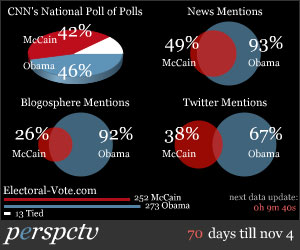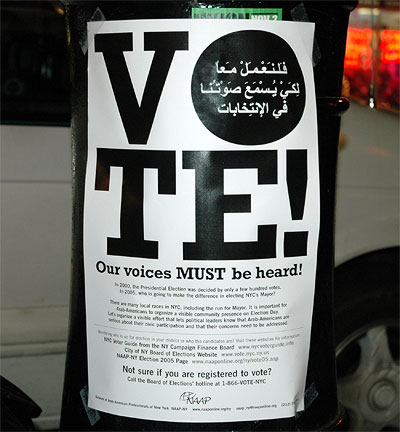election
Libya Ink

It’s amazing waking up in Brooklyn to see the euphoric tweets and pictures coming out of Libya as people vote in their first free election for more than 50 years.
A few recent picks:
I now feel that the 70 days I spent in prison didn't go to waste #LYelect #ليبيا #تنتخب
One young man at station said he didny sleep all night, can't wait to vote, been at stn since 5am! #Libya #LYElect #Benghazi
93y old lady voting for first time in her life #Gheryan #LyElect #Libya pic.twitter.com/3QyyMVwg
You wouldn't know it, but this man told me after his vote "inside I feel like I am flying" pic.twitter.com/mKk2Sfn4
The purple is election ink, a semi-permanent dye applied to voters’ fingers to prevent double voting. Those inky fingers are something special today.
 SocialDesignZine has a nice online gallery of posters from designers around the world, as well as Morteza Majidi’s photos of the election protests.
SocialDesignZine has a nice online gallery of posters from designers around the world, as well as Morteza Majidi’s photos of the election protests.To the Spoils, Go the Victories

2012 |
Candidates who spent the most won 94 percent of House races and 79 percent of Senate races. |
2010 |
In 85 percent of House races and 83 percent of Senate races, the candidate who spent the most money ended up winning. |
2008 |
“In 93 percent of House of Representatives races and 94 percent of Senate races... the candidate who spent the most money ended up winning.” |
2006 |
“In 93 percent of House of Representatives races and 67 percent of Senate races... the candidate who spent the most money won.” |
2004 |
“In 95 percent of House races and 91 percent of Senate races... the candidate who spent the most money won.” |
2002 |
“Just over 95 percent of U.S. House races and 75 percent of Senate races were won by the candidate who spent the most money.“ |
2000 |
“The candidate who spent the most money won 98 percent of the elections for positions in the House of Representatives. In the Senate the percentage was 85 percent.” |
1998 |
“In 94 percent of Senate races and 95 percent of House races, the candidate who spent the most money won.” |
1996 |
“92 percent of House races and 88 percent of Senate races were won by the candidate who spent the most on the election.” |
There are plenty of other factors (incumbents, for instance, tend to have a big financial advantage) but I found these numbers persuasive.
Updated November 11, 2012 to include 2012 numbers.

Flickr Riot
I’m late to the party on this, but as one of its co-founders notes in passing, the photo sharing site Flickr is fast becoming an easy way to find photos of major protest events in wired urban areas. See for instance, protests this week against the CPE in Paris or the election in Belarus. See also this December 2005 story on MoveOn’s use of Flickr or the 1,430 photos tagged “RNC.”
If Web 2.0 is made of people, an easy use is a kind of grassroots media. Though the corporate-owners of such Web frameworks are certainly willing to take down images that “may offend” or hand over the goods on users. (via)
Canada Out of Haiti!
Reader dru writes in about this graphic campaign around the upcoming elections in Canada:
“In February 2004, Canada backed a coup that removed Haiti’s democratically elected president (Aristide) and the entire elected government. Since then, they’ve been training police that have been shooting demonstrators, and propping up a ‘justice’ system that is systematically jailing political dissidents (the ones that aren’t in hiding or dead).
A bunch of Haiti solidarity activists are trying to unseat the Foreign Minister, Pierre Pettigrew (who had a brief cameo in The Corporation as a corrupt international trade minister), who played a key role (and continues to) in backing the post-coup government.
In the last election, he won by a very small margin in his riding of Papineau in north Montreal, which has a high population of Haitians.
In conjunction with groups in the Haitian community there, we're waging an all-out propaganda battle to unseat Pettigrew. Thousands of these posters: http://outofhaiti.ca/pettigrew/
Similar flyers have been distributed in the riding, and we hope to get a few thousand more out before election day (Jan. 23). Because the riding is such a hotspot, our posters have appeared on two nationally-broadcast TV news shows (in French and English).
Posters have also been created for the Prime Minister and his special advisor on Haiti and are going up in cities all across Canada.”
Read more about the campaign at http://outofhaiti.ca/
Get Out the Vote

It’s election day today in NYC. I spotted this in Bay Ridge Brooklyn this weekend.
The bilingual poster does not endorse a particular candidate or ballot initiative, simply the vote itself. It’s not trying to sell anything but political power.
The poster reads:
“There are many local races in NYC, including the run for Mayor. It is important for Arab-Americans to organize a visible community presence on Election Day. Let’s organize a visible effort that lets political leaders know that Arab-Americans are serious about their civic participation and that their concerns need to be addressed.”
Political power in New York City can often be drawn among community lines. This often becomes a game of numbers, and graphics in community spaces play a small but important part.
Words in Print
Just when you’re pounded by clients and far too busy to think about updating your blog, Print magazine publishes a nice little write-up pointing readers your way:
“Most designers agree, even insist, that design is more than clever imagery selling goods and services — it also influences how societies function. Social Design Notes, a remarkably informed and highly useful blog edited by John Emerson, explores design’s sociopolitical power and inspiration. A New York activist and designer who oversaw Web sites for Amnesty International USA and Human Rights Watch, Emerson launched his blog is 2002 as a ‘bridge between design activism — to push designers to think about acting in the public interest and to help activists see how design can facilitate their campaigns.’ Emerson explores how design is used to support and challenge the status quo, posting one historical note about the ‘Black Panther Coloring Book’ created by the FBI during the civil-right movement, and another about South Africa’s use of the comic book to prepare its citizens for their first election. Emerson also discusses the built environment, praising former New York mayor Rudolph Giuliani for having championed design to improve the lives of the disabled. And Social Design Notes’ Resource page contains tools — such as free stock photos — designed to convert readers into true reformers.”
The July/August 2005 issue also has a several excellent articles on sustainable design, and is worth checking out for this alone.
But it makes you wonder — why doesn’t the magazine itself use recycled paper? Despite the “In Print” column which touts the magazine’s “early environmental outlook,” this is not addressed. So, do they care about sustainability or not? I know design magazines are hardly a lucrative venture, but the article “Fiber Optimistic” on page 57 points out that cost differences between recycled paper and not are nowadays “negligible.”
But then why not take it a step further. If toxic printing processes and non-recycled paper are harmful to the environment, why not consider sustainability as a criteria for your annual design competition?
Imagine what a massive force the AIGA could be if they required printed entries to their annual showcase use recycled paper.
Would this punish designers for the choices of their clients? Perhaps, but then why shouldn’t judging the beauty of a product take into account the nature of physical object itself? If designers care about competitions, why shoudn’t they push their clients that much harder? Why don’t all design competitions consider sustainability as a criteria? Does this impose some kind of “political” viewpoint? One could argue that not requiring this broadcasts a political viewpoint just as clearly.
Would the AIGA’s dues paying members revolt? Certainly some, but as the issue of Print notes (p. 11):
“This year the AIGA formed a national task force to develop policies and programs for the organization in support of sustainability. Following a poll revealing the environment to be the profession’s most pressing concern, the Worldstudio Foundation and the AIGA, through their ‘Design Ignites Change’ collaboration addressing social issues on a local level, made sustainability the focus of their first project.”
Hell, the AIGA’s last national conference was largely devoted to discussion of sustainability.
So at what point does sustainable design cease to be a “special issue”? When does it become incorporated as a fundamental part of what we do? And when do our design institutions take a stand and show some leadership? When do we start demanding it?
Is this all unreasonable? I would point out that it’s already happened once before. The American Institute of Architects, another national design association, went through a very similar internal debate years ago and came out embracing the green.
...
Update July 18, 2005 — Print responds:
“It’s true, Print does not currently use recycled paper, but we are looking into doing so as soon as our current supply of paper is fully depleted. It has been an economic issue in the past, but we are hoping to persuade our publishers to spend a little extra on this aspect of responsibility.”




